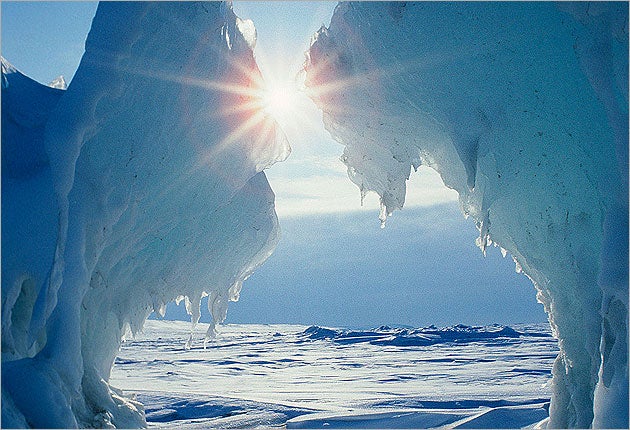Has the Arctic melt passed the point of no return?

Scientists have found the first unequivocal evidence that the Arctic region is warming at a faster rate than the rest of the world at least a decade before it was predicted to happen.
Climate-change researchers have found that air temperatures in the region are higher than would be normally expected during the autumn because the increased melting of the summer Arctic sea ice is accumulating heat in the ocean. The phenomenon, known as Arctic amplification, was not expected to be seen for at least another 10 or 15 years and the findings will further raise concerns that the Arctic has already passed the climatic tipping-point towards ice-free summers, beyond which it may not recover.
The Arctic is considered one of the most sensitive regions in terms of climate change and its transition to another climatic state will have a direct impact on other parts of the northern hemisphere, as well more indirect effects around the world.
Although researchers have documented a catastrophic loss of sea ice during the summer months over the past 20 years, they have not until now detected the definitive temperature signal that they could link with greenhouse-gas emissions.
However, in a study to be presented later today to the annual meeting of the American Geophysical Union in San Francisco, scientists will show that Arctic amplification has been under way for the past five years, and it will continue to intensify Arctic warming for the foreseeable future.
Computer models of the global climate have for years suggested the Arctic will warm at a faster rate than the rest of the world due to Arctic amplification but many scientists believed this effect would only become measurable in the coming decades.
However, a study by scientists from the US National Snow and Ice Data Centre (NSIDC) in Colorado has found that amplification is already showing up as a marked increase in surface air temperatures within the Arctic region during the autumn period, when the sea ice begins to reform after the summer melting period.
Julienne Stroeve, of the NSIDC, who led the study with her colleague Mark Serreze, said that autumn air temperatures this year and in recent years have been anomalously high. The Arctic Ocean warmed more than usual because heat from the sun was absorbed more easily by the dark areas of open water compared to the highly reflective surface of a frozen sea. "Autumn 2008 saw very strong surface temperature anomalies over the areas where the sea ice was lost," Dr Stroeve told The Independent ahead of her presentation today.
"The observed autumn warming that we've seen over the Arctic Ocean, not just this year but over the past five years or so, represents Arctic amplification, the notion that rises in surface air temperatures in response to increased atmospheric greenhouse gas concentrations will be larger in the Arctic than elsewhere over the globe," she said. "The warming climate is leading to more open water in the Arctic Ocean. As these open water areas develop through spring and summer, they absorb most of the sun's energy, leading to ocean warming.
"In autumn, as the sun sets in the Arctic, most of the heat that was gained in the ocean during summer is released back to the atmosphere, acting to warm the atmosphere. It is this heat-release back to the atmosphere that gives us Arctic amplification."
Temperature readings for this October were significantly higher than normal across the entire Arctic region – between 3C and 5C above average – but some areas were dramatically higher. In the Beaufort Sea, north of Alaska, for instance, near-surface air temperatures were more than 7C higher than normal for this time of year. The scientists believe the only reasonable explanation for such high autumn readings is that the ocean heat accumulated during the summer because of the loss of sea ice is being released back into the atmosphere from the sea before winter sea ice has chance to reform.
"One of the reasons we focus on Arctic amplification is that it is a good test of greenhouse warming theory. Even our earliest climate models were telling us that we should see this Arctic amplification emerge as we lose the summer ice cover," Dr Stroeve said. "This is exactly what we are not starting to see in the observations. Simply put, it's a case of we hate to say we told you so, but we did," she added.
Computer models have also predicted totally ice-free summers in the Arctic by 2070, but many scientists now believe that the first ice-free summer could occur far earlier than this, perhaps within the next 20 years.
Join our commenting forum
Join thought-provoking conversations, follow other Independent readers and see their replies
Comments
Bookmark popover
Removed from bookmarks